Behind the Lens – RJ Franklin
by Alex W.
Behind the Lens is an ongoing series of articles and interviews exploring the thought process behind successful and excellent photographers. It brings you behind the lens of a particularly excellent image and explains the technical and creative elements that went into creating the photograph.
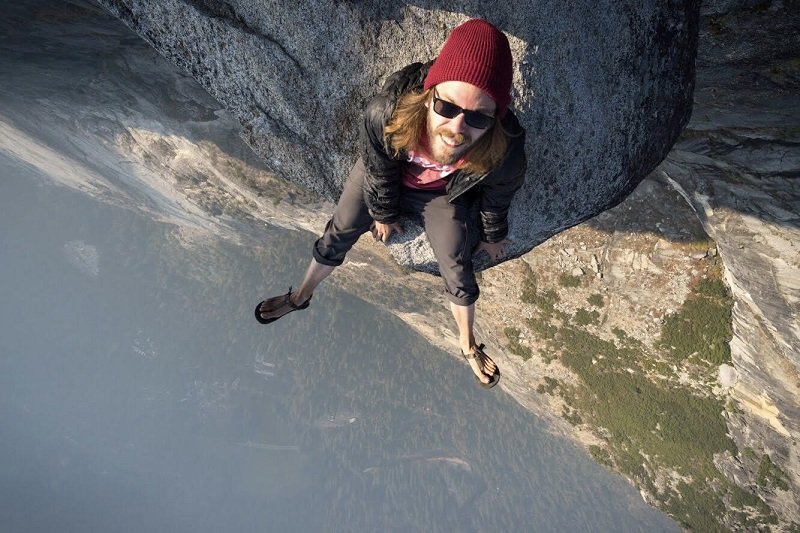
This week on Behind the Lens we meet RJ Franklin, a 29 year old landscape and astrophotography living and working in the beautiful Yosemite Valley. RJ spends most of his free time backpacking around one of the most iconic areas in the world searching for unique angles and perspectives on this well known mecca for nature lovers.
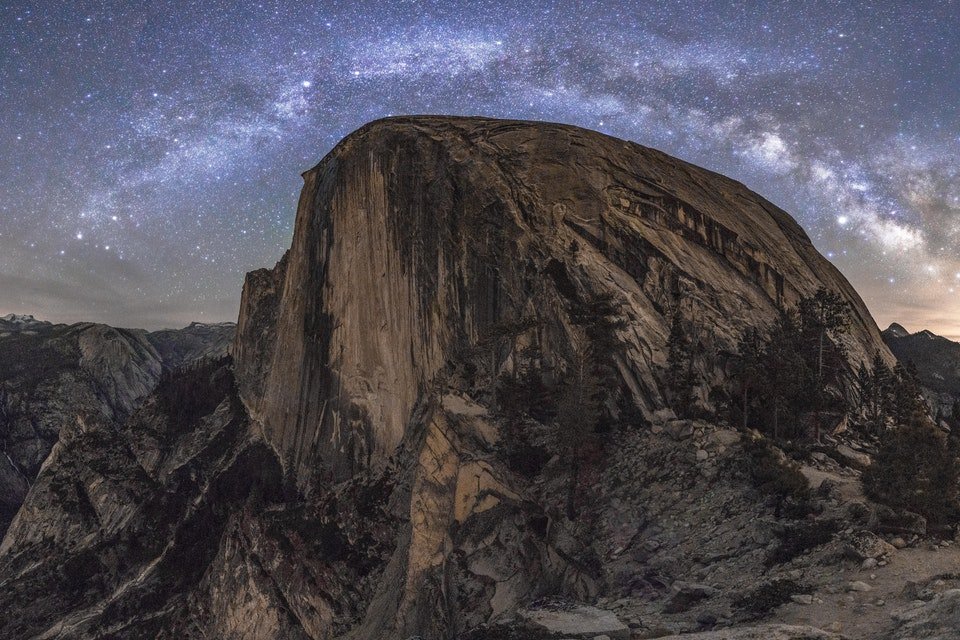
Click and Learn Photography: Hi RJ, firstly can you tell us a bit about yourself? How long have you been interested in photography and what was it that inspired you to pick up a camera in the first place?
RJ: My name is RJ Franklin, I currently live and work in Yosemite Valley. I’ve been playing with cameras almost every day since 2001. Around age 11 or 12 a few friends and I got into skateboarding and all we wanted to do was get a camera and film ourselves. We just wanted to really see how we looked! Now I didn’t realize it so early, but my friends had all tried to progress their skating. Meanwhile I was trying to figure everything out inside the camera. From settings to post production editing, everything I’ve learned was from trial and error. Time went on, and my friends focused on skateboarding as I continued to focus on the filming of skateboarding. My obsession with cameras began.
My grandfather was a photographer for one of the San Fernando newspapers after WW2 came to an end. I remember around age 8 he took me to the San Diego Zoo to go shoot pictures of the animals. There’s a shot of him and I and we both have cameras around our necks, this image is priceless to me. I feel like I can look back on the day I was introduced to the world of photography. After the zoo we went back to his house where he had his own dark room to develop what we had shot that day. I have no recollection of how to develop film but this memory stands out when I think of ‘What inspired me to pick up a camera ?’ Maybe my love for photography originates in my blood, I don’t know. Perhaps my grandfather showed me the magic at an early age and it burrowed deep into my brain for a later day.
Read More… Ultimate Guide to Autumn / Fall Photography
Click and Learn: That’s a heartwarming story RJ, it sounds like you were destined to pick up a camera from an early age!
From the image above it’s clear you’re not just photographing you friends skateboarding anymore though. It’s an incredible viewpoint of a well known mountain and looks like it took an enormous amount of planning and effort to get the arching of the Milky Way aligned perfectly. We’ll get on to that in a bit, but first I think the transition from skateboard photography to nature photography is an interesting one. How did that come about?
RJ: Thank you! I appreciate it. I used to work at GameStop, it was a fun job but like all good things it had to come to an end. So the day came when I found myself looking for a job and a place to live. One of my mom’s friends told me about working in Yosemite.
I was told “They would give you a job and they would give you housing. I think it’d be great for you.” That was all I needed to hear. I had been couch surfing for a few months before this and was desperate to find a bed. I applied to work in the park and told all my friends I’d be moving, months before I was even called back for an interview. Little did he know, Yosemite was the perfect place for me to go. If you’re out there and end up reading this.. Thank you, Jeff.
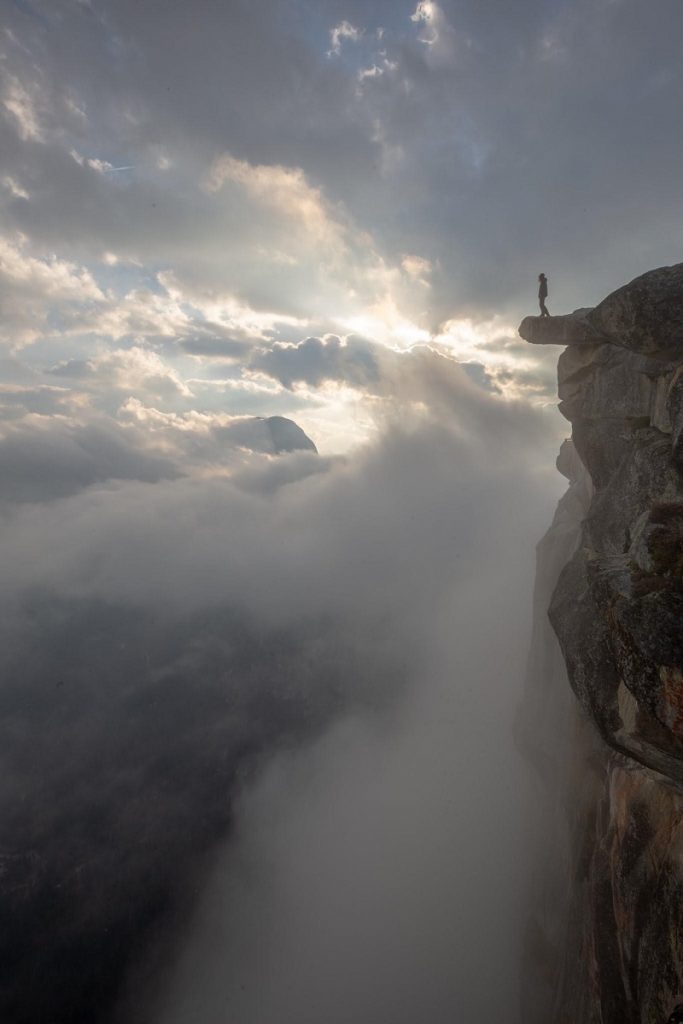
June 11th, 2013 rolls around and here I am entering my new home, Yosemite National Park. My original plan was to stay in the park for a few months then move back to Fresno, CA, but Yosemite got a firm grasp on me that first year. Within weeks I fell in love with the simplicity and lifestyle of living in a tiny cabin in the woods. In my first few months here in The Valley I had an itch for photography, but landscapes were so foreign at the time. I was searching so long for “The Perfect Photo”, and I feel like this held me back for years. I saw plenty of compositions that when shot, I blew them off only because Half Dome wasn’t dead center and the main attraction. So many shots were just pushed to the side and put on hold. At this time photography became sometime to do only when I couldn’t think of anything to do. “Oh, I’m bored. I guess I can pick up my camera and go take a couple pictures.” This went on for a couple years. Lots of shots were taken, but I don’t really feel like I captured anything spectacular during this time. Then came the day when my ex-girlfriend and I broke up. She left the park, and left me in a “What do I do now?” state of mind. Most my friends had left Yosemite by this time, except the one friend who’d been with me for years and years. My trusty Canon t2i. So without much time passing, it started to become a regular thing. Going to work? Grab your camera. Going to the store? Grab your camera. Everywhere I went I took it with me.
I soon became deeply immersed into landscape photography. I spent so much time wandering around Yosemite Valley shooting pictures of the same thing almost every day. The weather, light, and clouds can make the same image change so drastically in such a short amount of time. I was mesmerized by it. I slowly began to grow annoyed being down in The Valley, and often wondered about the vistas up top. There are a few other photographers who also live and work in the park, and really it was their work that inspired me to get off the valley floor. I saw so many different perspectives that winter, I became obsessed with pictures of Yosemite and began researching where I could shoot them from. I saw a shot from Eagle Peak, along with Ansel Adams’ masterpiece ‘Monolith’, and was blown away. I felt a desire to shoot these two photos and make them my own.
Click and Learn: I think it’s quite natural for the interest for photography to slowly build up over time, and there aren’t many better places to capture the imagination than the iconic Yosemite! There aren’t many landscape photographers in the world that aren’t influenced by Ansel Adams in some way, but how does it feel to actually be working the same patch as he did? Is it purely an inspiration to you, or is there some level of pressure that comes with it being the playground of one of the forefathers of landscape photography?
You mentioned how that constant perception of the changing light and seasons mesmerised you, and I think getting to the stage of noticing those subtle changes is incredibly important. Obviously local knowledge and a constant exposure to the area makes this step a lot easier. How important do you feel that your local knowledge is to capturing images such as this, especially in an area as tourist heavy as Yosemite?
RJ: It’s inspirational being in the same places as Ansel was. I don’t feel any kind of pressure from his work or any other photographers, really. If anything they inspire me and make me want to go find something new. Yosemite gets over 3 million visitors annually, and majority of these people take at least one picture while they are here. I look up Yosemite pictures frequently. I get a lot of ideas from people online like from Reddit or Instagram, but also from locals who’ve been here for years.
Yeah, I’d say knowledge of Yosemite has crucially helped my photography improve. I spent last summer really studying and paying attention to how the sun and Milky Way moved across Yosemite, kind of planning out this current year (2018) as I was going. It became a waiting game once November 2017 hit. I have this Milky Way checklist that I’ve been going after this year that I wrote out in December and by the looks of it I should get 90% of it completed by the end of the season. Hopefully more but this fire got in the way for a couple new moons, we’ll see.
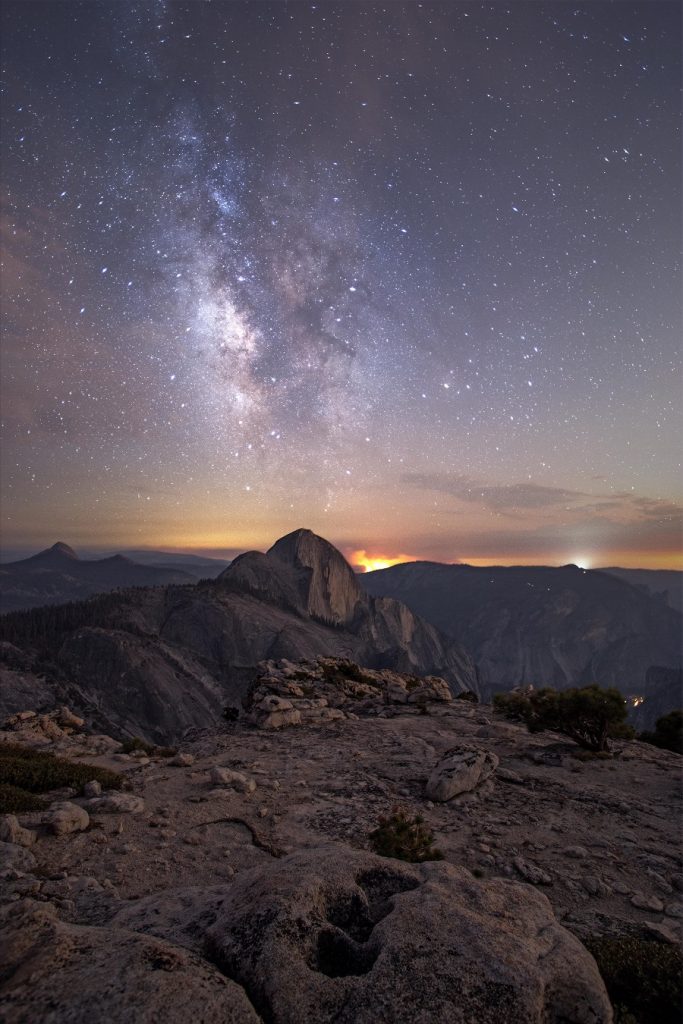
Click and Learn: It’s great that you’re on track to almost complete your list. I myself have a list that’s been steadily growing for about three years and I never get round to whittling it down!
Getting back to the photo of Half Dome – It’s obvious that it took a ton of planning and patience, so how did you actually go about planning the shot to have the Milky Way aligned so naturally with the mountain? Was it just from your observations or did you use apps such as Stellarium (or others) to help you, and is this a composition that you went out and found specifically for this shot?
RJ: Thank you! It really is a great feeling. Yes, that picture took lots of planning and patience. I was first taken up to The Diving Board last summer and tried this then. It took three attempts for me to find this place, twice be bailed on by unreliable ‘guides’. I arrived a month later than I would’ve preferred, but I didn’t know this at the time. I attempted to capture the Milky Way over Half Dome, but from this perspective Half Dome is so massive! With a 20mm lens I wasn’t able to get much foreground and sky in a single image. Well, at least as much as I was wanting. For months and months this was one of the main shots I thought about. I felt it slip away from my hands and the desire to capture it intensified.
This last winter we didn’t really get much of a winter. Snow didn’t arrive til March, and by then spring was trying to bloom. In December of 2017 I went up and camped at The Diving Board. I feel incredibly lucky to be able to camp here in December, not a single patch of snow or ice anywhere along the trail. We arrived, set up camp and began to head up to the actual ‘Diving Board’. There was an incredible sunset, the sky turned orange and red. One I never want to forget. After some food and relaxing, I began to make notes of when I would need to return. Seemed like I was going to have to come back in May. There are two apps that I use on my phone, Star Walk 2 [Android] [iOS] and PhotoPills. Star Walk makes it easier (for me at least) to zip through time extremely fast and see when and where our galaxy will be at a date that is far the future. PhotoPills has a price tag but VERY reliable. There is a Night AR feature that I mostly use, it helps tell you exactly where and when the Milky Way will be in your shot. PhotoPills also has lots of info that is very crucial to astrophotography and tells you different stages of the sky. What time blue hour ends and astronomical twilight begins. What time you’ll get your first view of the Milky Way’s core and how visible it’ll be. PhotoPills plays a great deal in my photography. I hike around the Valley without my camera these days, trying to find new night photos. I have tons of screenshots of Night AR readings just to use as an idea and maybe come back here at a later time.
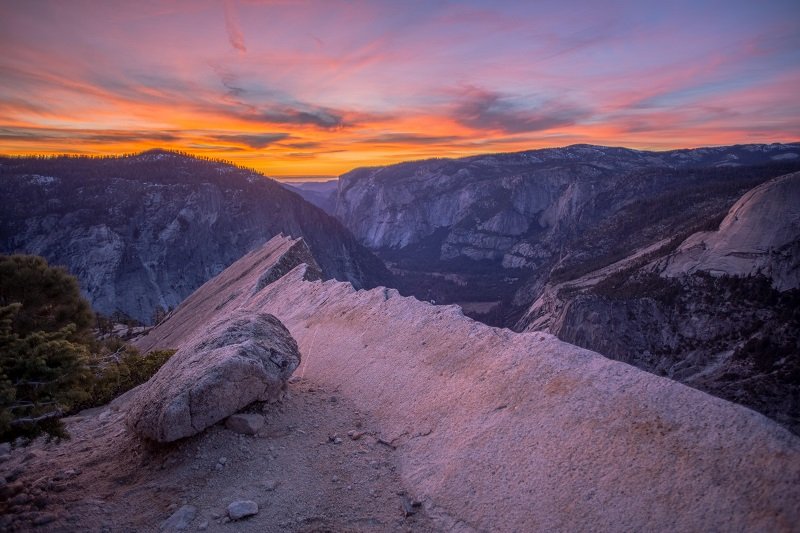
This shot is a multi-row panorama. I had to get a panoramic tripod head and learn how to use it to be able to complete this shot. At a total of 28 images, 7 wide and 4 tall, this took a total of 14 minutes to shoot. This was the only way I could think of adding more foreground and more sky to the image. This time shot at 16mm, I feel I achieved the look I was shooting for. Pun intended *wink wink*. This was a composition I saw in one of Ansel Adams’ more famous photographs, and one I mentioned earlier, ‘Monolith’. I wanted to make it my own. I really like his version and just wanted one of my own that would look good beside it. As far as my Milky Way photography goes, I had still been searching for my ‘Perfect Photo’. In my head all I saw was a large, very defined Half Dome with the Milky Way arching over it.I didn’t realize it when shooting it, but I had just found and shot my ‘Perfect Photo’. I hate to say it like that, but that’s what I feels like. My Magnum Opus. It might be years before I can top it.
You Might Like… Astrophotography – A Beginner’s Guide to Improving Your Night Photography
Click and Learn: That’s a really telling story of the vision and patience required in landscape photography, and it’s even more important in astrophotography. It’s almost like every image is a journey from the conception of the idea to the finished product.
I’ll have to take a look at StarWalk, but PhotoPills is something I definitely recommend to landscape photographers despite not being free. I flit between The Photographer’s Ephemerisand PhotoPills and recommend them both in my Ultimate Guide to Landscape Photography (noting how PhotoPills is better for astrophotography purposes as well)
It’s pretty cool that you had such faith in this composition that you actually went and bought new gear specifically for that shot. While we’re on the topic – What are you shooting your astrophotography images with, and do you feel like the gear you have is more important in astrophotography than other genres because of the need for high ISOs and wide apertures? And how much of a difference does having a good level post-processing skills matter when dealing with the night sky?
RJ: Patience is key! I feel without it my photography wouldn’t be what is has become. Most of the time, for me at least, that perfect little window of light can only last a few seconds to minutes. Next thing you know the color is fading from the clouds and the purples begin changing to a subtle gray. Waiting for that right second is just part of the game.
I shoot with a Canon 6D. Last year I was using two lenses all year, a Canon 20mm f/2.8 and a Canon 35mm f/2. Earlier this year I had the opportunity to get a Canon 16-35mm f/2.8L II at a bargain, so I sold the previous to lenses and pretty much run around with this 16-35mm as my go to. I also have a Canon 50mm f/1.4 and a Canon 24-105mm f/4L, those just aren’t used as often. Wide lenses have been my thing in both skateboarding and landscapes, I’m very comfortable with them. I had a Canon t2i before upgrading to my current 6D. While that was capable of capturing the Milky Way, I wanted something that was full frame and able to get a higher ISO than what I was able to do at the time.
I haven’t used lots of other cameras or lenses so it’s hard to say if it is the gear that makes the photo. I hope so because I’ve dropped lots on these lenses, HA! But I have definitely noticed major differences in my finished images just from learning new little things about editing in Lightroom or Photoshop. I’ll occasionally look up people’s work flows on YouTube and see if they do anything differently. Most times I’ll learn something new that I had no clue of, it’s become a very helpful task that I’ve started doing at least once a week. Now most my adventures are planned around the night sky, but I still have lots of fun in the day time as well. My 16-35mm gets great sun stars when stopped up to f/18, I’ve been chasing those a lot lately. Sunsets, sunrises, and the night sky. It’s been a very sleep deprived year.
You Might Like… What is the Best Lens for Astrophotography?
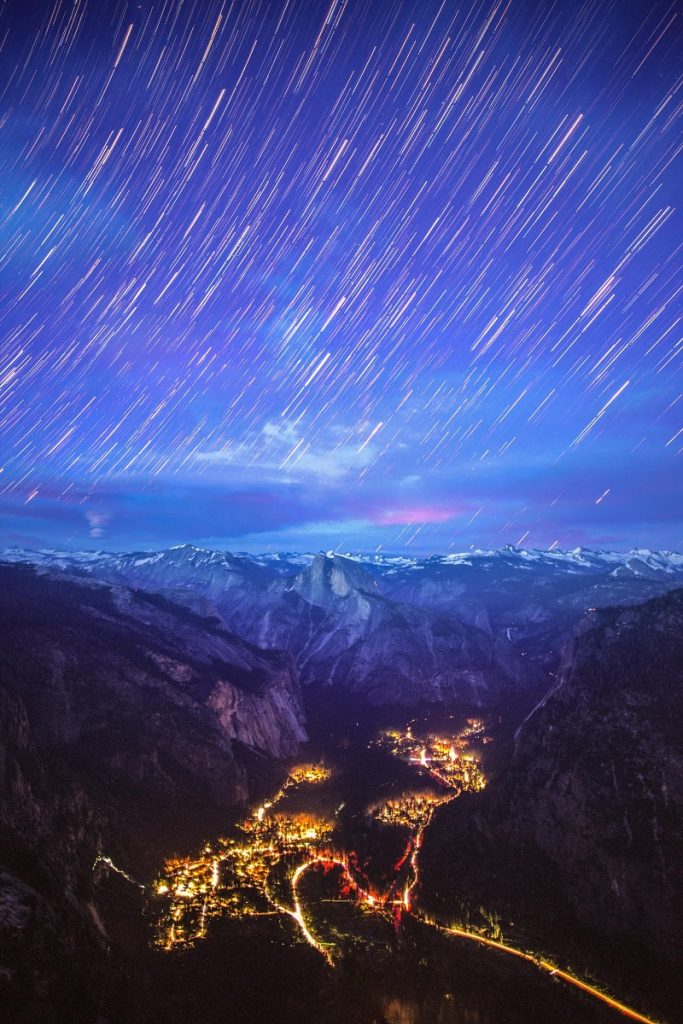
Click and Learn: I definitely noticed a marked difference in quality when I upgraded to my Nikon D810 from cropped sensor. That high ISO capability just makes everything so much easier to plan for! That’s a good tip for learning new post processing skills and I’ll definitely be trying that. It’s very easy to get into a comfortable rut when you’re editing your images, but there’s just so much out there to learn that you can almost always improve yourself in some way.
It definitely sounds like you’ve been busy this year! I find it hard enough getting out for one or two sunrises a week during the summer months so I admire your dedication. I found this image (below) on your website which I think really sums up the diversity of your photography. A stunning panoramic view showing both the end of a day and the start of the night. Since you work on both sides of the coin, do you think there is anything that a run-of-the-mill landscape photographer needs to learn if they want to progress in astrophotography? Or do you feel like all the skills are pretty much transferable?
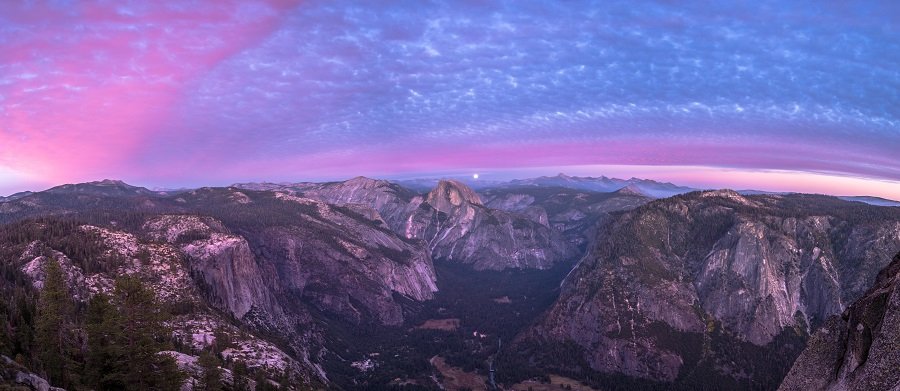
RJ: That was one thing that I think kept my photography rapidly progressing so quickly, learning new techniques about editing. It’s definitely helped lots.
Thank you! I’d say if anything, you’d just need to learn about long exposure photography. Once that all clicked for me, everything in astrophotography started to make sense. There’s quite a bit to learn, but it’s nothing harder than learning what you already know about photography. You’re playing with light now over a period of time, this is going to take lots of time to master. There is a group on Facebook called “Milky Way Chasers” and I’ve been a part of it for a few years now. I’ll mostly check out what other group members are posting and ask whatever question comes to mind. The community there is usually really helpful and (most times) will answer your questions.
Click and Learn: Thanks for that, I’ll link the Facebook group here so anybody interested can take a look. [Facebook group here]
Finally, do you have any specific plans for the future with regards to your photography, or are you just letting it take you wherever it takes you and enjoying the experience?
RJ: I have a few things left on my Milky Way list, but really those are just goals for 2018 and if I can’t complete them this year I’ll throw a couple of them over to next years list. No really specific plans, just try to keep shooting as often as possible. I’m kinda letting my camera and spontaneous ideas guide me as I go.
This was a lot of fun, thank you for the opportunity and for involving me on your site.
RJ Franklin is a 29 year old landscape and astrophotographer living and working in Yosemite Valley. He’s spent the last five years exploring this iconic national park as he searches for unique takes on some of the most photographed landscapes in North America. See more of his work below.
Read More…
The Photographer’s Glossary – A Guide to Common Photography Terms
Photography in the Rain – Making the Most of a Rainy Day
Ultimate Guide to Forest Photography
 |
 |
 |
 |

About Alex W.
Alex is the owner and lead writer for Click and Learn Photography. An avid landscape, equine, and pet photographer living and working in the beautiful Lake District, UK, Alex has had his work featured in a number of high profile publications, including the Take a View Landscape Photographer of the Year, Outdoor Photographer of the Year, and Amateur Photographer Magazine.
Thoughts on "Behind the Lens – RJ Franklin"
 |
 |
 |
 |
You can Get FREE Gifts. Furthermore, Free Items here. Disable Ad Blocker to receive them all.
Once done, hit anything below
 |
 |
 |
 |